-
| The SPEAR FAMILY | The AXE FAMILY | The POLE CLEAVER | - | SPECIAL CASES | COMBINATION WEAPONS |
| Spear | The Pole Axe | Voulge | Fauchard | Lucern Hammer | - |
| Lance | Halberd | Lochaber Axe | Glaive | Bec de corbin | Fauchard-fork |
| Pike | Bardiche | - | Guisarme | - | Fauchard-guisarme |
| Spetum | - | - | Bill Hook | - | Glaive-guisarme |
| Ranseur | - | - | Military Fork | - | Guisarme-voulge |
| Partisan | - | - | - | - | Bill-guisarme |
| - | - | - | - | - | Hook-fauchard |
| - | - | - | - | - | - |
| - | - | - | - | - | - |
| Weapons | - | - | - | - | Unearthed Arcana |
-
An astonishing number of different weapons were employed during
the medieval period. What is nearly as surprising is the lack of uniformity
of names by which these weapons are called. Seemingly, authors
who should be authorities in this regard carelessly brand one
sort of weapon under an entirely mistaken classification, thus confusing
the uninformed reader and generally making identification difficult
and uncertain. An outstanding example of this misnaming of weapons
appears in Warriors and Weapons of Early Times by Niels
M. Saxtorph,
where an obvious morning star
is identified as a mace. While
the general use of both weapon types is the same, they differed sufficiently
to make it rather important to distinguish between the two, viz.:
a mace is usually a short-shafted weapon with a flanged head, the
whole cast in one piece; a morning star is a longer weapon, typically
employed by infantry, with a wooden shaft and head, the latter set
with radiating spikes.
If errors in terminology can be found in works dealing with such easily
identifiable and classifiable weapons as maces and morning stars,
readers are cast into a veritable morass of disagreement - possibly
out-and-out-error -- with studies that treat the scores of pole arms
common during the Middle Ages.
Such confusion must be anathema to the serious student of the
medieval period, be he historian or historical game enthusiast. Based
upon research of the subject done for various reasons, a system of
classification and nomenclature is presented here that seems both
reasonable and easy to use. But first, let us consider just what medieval
weapons were.
Most weapons employed during the Middle Ages were either developments
of hunting weapons or adaptations of agricultural implements.
Arms developed from simple, basic forms into more
sophisticated ones as the art of warfare developed during the centuries.
Weapons from the late medieval period were either far more specialized
than the models from which they sprang, or else were
combination weapons trying to combine the strengths of the more
specialized arms. In fact, it is the classification of the highly specialized
weapons and the multi-formed ones which cause so much confusion
amongst writers. The differences are important, and they must
be made clear.
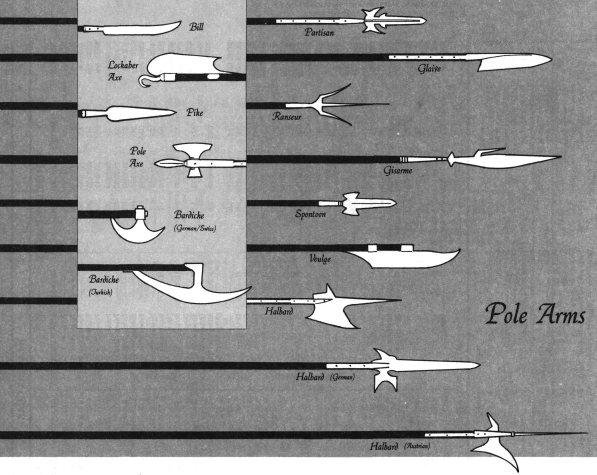
To begin with, a definition of pole arm should be set. A pole arm is,
in
simplest terms, a weapon on the end of a stick. Pole arms are infantry
weapons. The additional reach the pole gives affords the wielder of
the weapon the advantage of striking the enemy before he himself
can be struck, or holding the enemy at a distance. The ultimate pole
arm was the 18-21 foot pike -- but an axe blade attached to a 5-foot
long
haft is just as much a pole arm, so it is already evident to the
reader just how wide a number of weapons is encompassed by the
term.
The system of classification outlined here presupposes that any
weapon considered has a haft or shaft length of not less than 5 feet.
<>
The pole arm was developed in order to put infantry on even terms
with cavalry. This it did admirably in the hands of well trained, disciplined
formations such as those of the Swiss (who mixed pike,
halberd/Lucern hammer/morning star, and crossbow/arquebus in almost
equal proportions - 40-40-20 as an average), who could hold
the best European cavalry at bay with laughable ease in pike square.
The Germans emulated the Swiss with close to the same success,
and most other European armies fielded large bodies of pole-armed
infantry (with something less than great success in most cases). The
reason for the proliferation of the pike was that it proved the most
useful
for keeping horsemen at a distance. (Swiss pikemen did not
ground the pike butt to accept a cavalry charge, but rather held the
rear part of the shaft higher than the front, so the points which
glanced off armor would not go uselessly into the air but would be
forced downward into rider or mount - or at worst, into the ground
to
form a barrier.)
Other pole arms gave way to pike and halberd for one or two reasons.
Those with massive heads were not as efficient as the pike; when
their shafts were lengthened past a certain limit, they were too cumbersome
to wield. (Spear-type pole arms were lengthened to pikes
and were then called just that - there are ox-tongued and spetumlike
heads, but the pike shaft is too long for useful employment of ranseur
or partisan heads.) Those which were shortened for use as
cleaving weapons were not as efficient as the halberd, or were
changed so that they became almost indistinguishable from the halberd
(typically guisarme-voulge forms).
The evolution of the pole arm is of great interest, as it reflects the
trends in armor and tactics in medieval warfare. It also is of great
help
in understanding why battles were fought as they were and can help
to explain some of the outcomes. My system of nomenclature is derived
from early reading of the Encyclopedia Brittanica and ffoulkesís
book (see below). Further study and careful observation of weapons
has brought it to its current state - by no means positively final,
complete
or unimpeachable, but nonetheless useful and logical for accurate
identification and naming of medieval pole arms.
Bibliography
Ashdown, Charles, Armour and Weapons in the Middle Ages (London
1925); British and Foreign Arms and Armour (London 1909)
ffoulkes, Charles, Armour and Weapons (Oxford 1909)
Oman, C.W.C., A History of the Art of War in the Middle Ages (two volumes, London 1924)
Saxtorph, Niels, M., Warriors and Weapons of Early Times and Use of Arms and Armor (New York 1934)
Encyclopedia Brittanica, Eleventh Edition (New York 191 0-1 1)
Q: Can a character
with a girdle of
giant strength throw a halberd?
A: When one of my
players tried to do
this I allowed it, but with
a big to-hit
penalty.
You were correct. Pole arms
are not
intended to be thrown, no
matter what
the thrower?s strength.
Anything, however,
can be thrown with some
chance of
success. For throwing a
pole arm, we
suggest a to-hit penalty
of -4 at short
range (10? or less), -6
at medium range
(11-20?), and -9 at long
range (21-30?). We
also suggest that you use
these ranges
outdoors where other missiles
have ranges
measured in yards. A pole
arm is far too
long for a human-sized creature
to throw
like a hand axe (so that
the weapon spins
or tumbles), no matter how
much strength
is available. Spear-type
throws are possible,
but hits can inflict damage
only if the
pole arm that is thrown
has a spear point.
Use spear damage (1-6) in
this case, not
pole-arm damage.
(150.9)
The pole arms illustrated on these pages are drawn in
scale with respect to each other; and are shown here at
approximately 1/20 of their actual size; the lance on the
right edge of this page is 71/2 inches long
from tip to tip, or
15 feet long in scale. This size ratio only applies to the
lengths of shafts and the general size of blades or points
placed thereon; the thickness of a shaft or the detailed dimensions
of a complex blade may not be literally in scale.
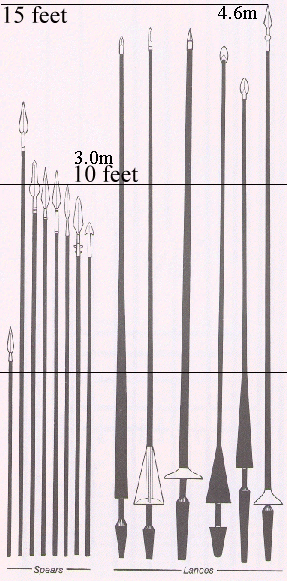

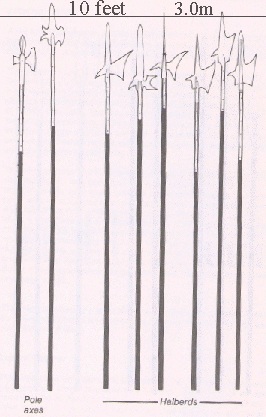
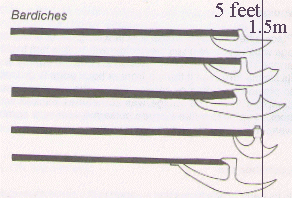
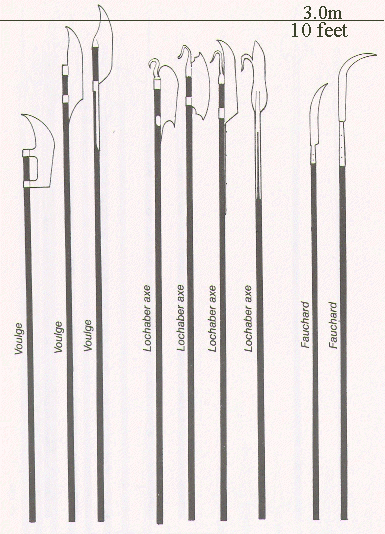

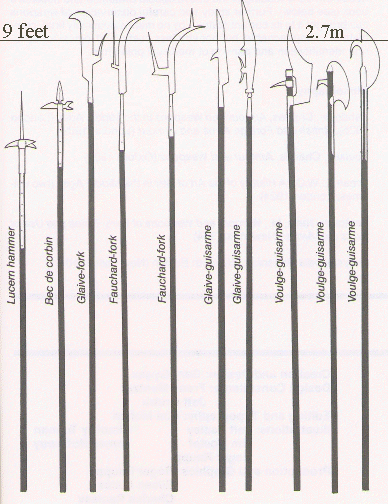
| Spear | - | Lance | - | Pike |
| - | - | Pole Arms | - | - |
Other Members of the Spear Family
| Spetum | Ranseur | Partisan | Pole Arms |
We now come to the many specialized & combination forms of the dagger
on a stick.
This is not to say that all pole arms equipped with
a spear head (dagger) should be considered as spears
or variations thereof.
To the contrary, this is an error all too common amonst writers treating
pole arms, identifying the weapon by a secondary rather than a primary
function, and losing all sense of what the weapon was for (as will be demonstrated
later).
The primary function of a spear is thrusting; thus, the specialized
& combination pole arms beloning in the spear family should be primarily
used as thrusting weapons.
| The pole axe | Halberd | Bardiche | Pole Arms |
The pole axe
The axe took many forms and was combined with many basic forms
of weapon to make a prolific family, but some of the pole arms bearing
the name do not really belong to the genre. The axe has two basic
head forms, broad and narrow. The latter form is usually thicker than
the other, in order to give it the necessary weight. A related form
of the
axe is the cleaver, a butchering tool which was adapted for military
use also. Many pole arms in the axe and cleaver families also had
spear points to provide some secondary thrusting
capability, but
again the primary use of the weapons of these types was chopping at
oneís opponent rather than thrusting toward him.
Strictly speaking, a pole axe is nothing more than an axe head of any
sort set upon a long haft in order to deliver an earlier and more forceful
blow. It can be double-bitted, backed by a spike, andlor topped off
with a dagger (spear) point, but it is still recognizable as an axe.
The great axe is a bardiche
|| halberd
(which are both poleaxes).
(79.16)
| Voulge | Lochaber Axe | - | Pole Arms |
It seems quite likely that some outraged peasant fastened his meat
cleaver to the end of a stave in order to protect himself and his family,
and thereby created a weapon form which was to be widely used in
both Europe and the British Isles for several centuries. The same derivation
holds true for the majority of the other pole arms which will be
discussed; they are simple agricultural tools converted to a warlike
use, and their form is easily distinguishable and identifiable until
they
become so combined and sophisticated as to prove some difficulty in
easy classification. Even this latter transition is not too difficult,
however,
if the reader is well versed in the basic forms of each basic peasant
tool-cum-weapon.
| Lucern Hammer | Bec de corbin | - | Pole Arms |
A few other designs can also be mentioned here, more or less in pass-
ing, as they pertain to weapons which are not true pole arms, but their
size is such that they are sometimes considered in the general class.
The threshing flail, a wooden handle with another billet of wood attached
to it by a swivel or several links of chain, was easily adapted
and modified to become a ghastly weapon. Horsemen commonly employed
a short-handed flail with one or more chains ending in smooth
or spiked iron balls. The peasantís tool made a far more effective
weapon when swung by a strong man. From a heavy shaft of about 3
to 4 feet in length was hung one or two rods of metal shod and spiked
wood or iron. The whole weapon was over 5 feet long and had tremendous
penetration and crushing power.
The other weapon which is a borderline case is the morning star. This
club adaptation was typically a heavy wooden haft from 3í to 5Ď or
more in length, atop which was set a cylinder, barrel, or truncated
cone, also of wood, metal-bound, and set with vicious metal spikes.
Also called the holy water sprinkler (or godentag in the Low Countries),
it was a favorite of the peasants, for it was easy to make and
could lay low the best armored opponent at a blow. For some time it
was used extensively by the Swiss, although the halberd eventually
replaced it. The weapon was often tipped with a spear point in its
longer form, so that some models were long enough to be pole arms.
Some military picks were also pole-mounted, having shafts of 5 feet
or greater length.
There are also two pole arms which were certainly developed purely
as weapons. There is a resemblance between the two, but they are
separate and distinct.
| Fauchard-fork | Fauchard-guisarme | Glaive-guisarme | Guisarme-voulge |
| Bill-guisarme | - | - | Pole Arms |
One final thing needs comment. Sometimes a weapon with an added
feature is identified as the added part rather than as the major
weapon. For example, an axe head attached to the end of what is basically
a spear (Le., the partisan) is not called a pole axe, for the length
of the shaft and the predominant employment of the point make it
rather obviously a thrusting weapon with added secondary functions.
A glaring example of misidentification is found in Stoneís A Glossary
of the Construction, Decoration, and use of Arms and Armor. Therein,
the author shows a halberd with a fork tip rather than the usual
daggerlspear point and identifies it as a military fork. Now, were
the
shaft of the weapon 8 feet or more in length, this might be proper,
but
it is a halberd-sized pole, and the weapon is simply a halberd with
an
incidental fork atop it.
Confusion regarding certain combination weapons of the fauchard-glaive
voulge-guisarme-bill types is certainly understandable, and
care must be taken in identifying such weapons. Careful examination
of the length of the shaft and the shape of the head will give clues
as
to its primary uses in combat, and hence its identity.
RANDOM POLE ARM GENERATION (version 1)
1. Bardiche
2. Bec de Corbin
3. Bill-Guisarme *
4. Fauchard
5. Fauchard-Fork
6. Fork, Military
7. Glaive
8. Glaive-Guisarme
9. Guisarme
10. Guisarme-Voulge
11. Halberd
12. Hammer, Lucern
13. Hook Fauchard
14. Lance
15. Partisan
16. Pike, Awl
17. Ranseur
18. Spear
19. Spetum
20. Voulge
RANDOM POLE ARM GENERATION (version 2, with mnemonic names added)
1. Bardiche
2. Bec de Corbin
3. Bill-Guisarme *
4. Fauchard = Pole Scythe
5. Fauchard-Fork
6. Fork, Military
7. Glaive = Pole Knife
8. Glaive-Guisarme = Pruning Knife
9. Guisarme = Pruning Hook
10. Guisarme-Voulge = Pruning Cleaver
11. Halberd
12. Hammer, Lucern
13. Hook Fauchard = Hook Scythe
14. Lance
15. Partisan
16. Pike, Awl
17. Ranseur = Pole-Sai
18. Spear
19. Spetum = Tri-Spear
20. Voulge = Pole Cleaver
RANDOM POLE ARM GENERATION (version 3, with mnemonic names added)
01-05. Bardiche
6-10. Bec de Corbin
11-13. Bill-Guisarme
14-15. ^Scorpion
16-20. Fauchard
21-25. Fauchard-Fork
26-30. Fork, Military
31-33. Glaive = Pole Knife
34-35. ^Couteaux de Breche
36-40. Glaive-Guisarme
41-45. Guisarme
44. ^Bill
45. ^ Bill Hook
46-48. Guisarme-Voulge
49-50. ^ Lochaber Axe
51-55. Halberd
56-58. Hammer, Lucern
59-60. Mancatcher
61-65. Hook Fauchard
66-67. Lance (light horse)
68-69. Lance (medium horse)
70. Lance (heavy horse)
71. Mancatcher
72-73. Partisan
74-75. ^ Bohemian Ear Spoon
76-80. Pike, Awl
81. Ranseur = Pole-Sai
82. ^Chaves Souris
83. ^Ransom
84. ^Rhonca
85. ^Rhoncie
86. ^Runka
87-90. Spear
91-93. Spetum
94. ^Corseque
95. ^Korseke
96-00. Voulge
1. Bardiche
2. Bec de Corbin
3. Bill-Guisarme
4. Fauchard (pole-sickle) (dismounter!)
5. Fauchard-Fork (pole-sickle) (dismounter!)
6. Fork, Military (dismounter! charge receiver!)
7. Glaive (pole-knife)
8. Glaive-Guisarme (pole-knife & pruning hook)
9. Guisarme (pole-knife)
10. Guisarme-Voulge (pole-knife / pole-cleaver)
11. Halberd
12. Hammer, Lucern
13. Hook Fauchard (pole-sickle)
14. Lance (light horse)
15. Lance (medium horse)
16. Lance (heavy horse)
17. Partisan (broad-spear)
18. Pike, Awl
19. Ranseur (tri-spear)
20. Spear
21. Spetum (pole-sai)
22. Voulge
<make links>
<extend with PH variants>
>
<note: one of them is a pole-can-opener, and one of them is a pole-swiss-army-knife. lucern hammer & bec de corbin?>
<when this is finished, a slightly edited v. can be sent back to the PH for those who play 1E3>
Thus, the spear family is composed
of the spear proper;
the long spear, or pike;
the spetum;
the ranseur;
and the partisan.
All weapons of this class are
basically daggers atop a sturdy pole,
with trimmings added to make the weapon more efficient
in one way or another. <HALVE a spear = dagger + maybe a 10' pole?>
<
the following is just theory, following the :
Just as with the spear and
pike,
many different heads were attached to the lance shaft
to meet the requirements of varying opponents armor. ,
at lance.
-9
| Weapon Type | Approximate
Weight in Pounds |
Size S or M | Size L | Notes | Length | Space Required | Speed Factor | 0 | 1 | 2 | 3 | 4 | 5 | 6 | 7 | 8 | 9 | 10 |
| Spear | 4-6 | d6 | d8 | - | 5-13' <d4+d6+3> | 1' | 6-8 | -2 | -2 | -2 | -1 | -1 | -1 | 0 | 0 | 0 | 0 | 0 |
-6
| Weapon Type | Cost | Approximate
Weight in Pounds |
Size S or M | Size L | Notes | Length | Space Required | Speed Factor | 0 | 1 | 2 | 3 | 4 | 5 | 6 | 7 | 8 | 9 | 10 | Save As |
| Pike, Awl | 3 gp | 8 | d6 | d12 | - | 18' <15-18'> | 1' | 13 | -1 | -1 | -1 | 0 | 0 | 0 | 0 | 0 | 0 | -1 | -2 | [Wood, thin] |
-11
| Weapon Type | Cost | Approximate
Weight in Pounds |
Size S or M | Size L | Notes | Length | Space Required | Speed Factor | 0 | 1 | 2 | 3 | 4 | 5 | 6 | 7 | 8 | 9 | 10 | Save As |
| Lance (light horse) | 6 gp | 5 | d6 | d6 | - | 10' | 1' | 7 | -3 | -3 | -2 | -2 | -1 | 0 | 0 | 0 | 0 | 0 | 0 | [Wood, thin] <-1?> |
+3
| Weapon Type | Cost | Approximate
Weight in Pounds |
Size S or M | Size L | Notes | Length | Space Required | Speed Factor | 0 | 1 | 2 | 3 | 4 | 5 | 6 | 7 | 8 | 9 | 10 | Save As |
| Lance (medium horse) | 6 gp | 10 | d6+1 | 2d6 | - | 12' | 1' | 6 | -1 | 0 | 0 | +1 | +1 | +1 | +1 | 0 | 0 | 0 | 0 | [Wood, thin] |
+22
| Weapon Type | Cost | Approximate
Weight in Pounds |
Size S or M | Size L | Notes | Length | Space Required | Speed Factor | 0 | 1 | 2 | 3 | 4 | 5 | 6 | 7 | 8 | 9 | 10 | Save As |
| Lance (heavy horse) | 6 gp | 15 | 2d4+1 | 3d6 | - | 14' | 1' | 8 | +4 | +4 | +3 | +3 | +2 | +2 | +2 | +1 | +1 | 0 | 0 | [Wood, thin] <+1?> |
>
<
POLE ARMS, RANDOM GENERATION
RANDOM POLE ARM GENERATION (version 3, with mnemonic names added)
01-05. Bardiche
6-10. Bec de Corbin
11-13. Bill-Guisarme
14-15. ^Scorpion
16-20. Fauchard
21-25. Fauchard-Fork
26-30. Fork, Military
31-33. Glaive = Pole Knife
34-35. ^Couteaux de Breche
36-40. Glaive-Guisarme
41-45. Guisarme
44. ^Bill
45. ^ Bill Hook
46-48. Guisarme-Voulge
49-50. ^ Lochaber Axe
51-55. Halberd
56-58. Hammer, Lucern
59-60. Mancatcher <>
61-65. Hook Fauchard
66-67. Lance (light horse)
68-69. Lance (medium horse)
70. Lance (heavy horse)
71. Mancatcher <>
72-73. Partisan
74-75. ^ Bohemian Ear Spoon
76-80. Pike, Awl
81. Ranseur = Pole-Sai
82. ^Chaves Souris
83. ^Ransom
84. ^Rhonca
85. ^Rhoncie
86. ^Runka
87-90. Spear
91-93. Spetum
94. ^Corseque
95. ^Korseke
96-00. Voulge
<hyperlink above, and finish below>
Damage vs. Opponent
>
<note: the pike was always used in mass ... if a pike is generated,
then it is a pike unit. the first 10 rolls for pole arms (incl. this one),
get changed to pike>
Damage vs. Opponent
| Weapon Type | Approximate
Weight in Pounds |
Size S or M | Size L | Notes | Length | Space Required | Speed Factor | 0 | 1 | 2 | 3 | 4 | 5 | 6 | 7 | 8 | 9 | 10 |
| - | - | - | - | - | - | - | - | - | - | - | - | - | - | - | - |
Question: I have just
started playing AD&D and I donít
know what the following
weapons are: Bardiche, Bec
de Corbin,
Bill-Guisarme,
Fauchard,
Fauchard-Fork,
Flail, Glaive,
Glaive-Guisarme,
Guisarme,
Guisarme-Voulge,
Lucern
Hammer,
Partisan,
Pick, Ransuer, Scimitar,
Spetum
and Voulge.
Can you tell me what they
are?
Answer: Alas, I donít
have the space to do so. However, all the
weapons but the Pick and
Scimitar can be found in The Dragon #22, in
an article on pole arms.
(Update: Appendix
T of UA is the updated version of the article
in The Dragon #22).
Coffee wrote:
Hi, Gary!
I know you hear this all the time, but I wanted to say thanks for all you've done in the roleplaying hobby, from starting it with the creation of D&D all the way to answering questions from all of us fellow gamers. I can't count the number of happy hours I've spent roleplaying, most of it in AD&D.
Anyway, here's my question:
How many times have you seen, either as a player or as DM, a player character
actually using polearms like the bec de corbin or the guisarme
glaive?
I keep seeing these things
pop up on weapons lists (most recently in Castles and Crusades), but I've
never seen or heard of anyone actually using them. Halberd, yes; bec de
corbin, no.
Thanks again!

Welcome of course.
Pole-arms are not meant for
PCs.
they are meant for men-at-arms,
soldiers, humanoids such as orcs, hobgoblins,
gnolls, and bugbears.
i have had had such NPC
figures so armed any number of times--and think of the scenes showing them
in Return of the King!
![]()
Gary